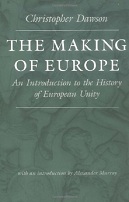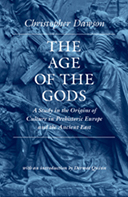This work, first published by Sheed & Ward in 1934 under the title Mediaeval Religion and Other Essays, is a transcript of the four Forwood Lectures which Dawson delivered at Liverpool University in 1934, plus two additional essays. In it, Dawson presents a re-evaluation of medieval society, seeing it not as an unfortunate episode between the Roman Empire and the Renaissance, but as the crucible of the modern world, as well as a fascinating and rich culture in its own right. Though currently out of print, the six essays can all be found in his later work Medieval Essays.
Central Themes
In the first lecture, The Sociological Foundations, Dawson sets out the importance of the Middle Ages for the modern historian. “Those thousand years saw the making of Europe and the birth and rebirth of Western Culture… They have left an indelible imprint on both our social and religious life.”
The central force which was able to guide this process through the ups and downs of the Dark Ages and the Middle Ages were the monasteries, which prevented the Church from falling into the abyss of secular power by repeated reforms. These emanated first from the Benedictine monasteries and later from the abbeys of Cluny and Clairvaux. It was, according to Dawson, “the essential monastic ideals of asceticism and otherworldliness and fidelity to the Rule that gave [the Church] its spiritual independence, its power to resist the pressure of its environment and to initiate movements of religious reform.”
For Dawson, “The Middle Ages were not the ages of Faith in the sense of unquestioning submission to authority and blind obedience. They were ages of spiritual struggle and social change, in which the existing situation was continually being modified by the reforming energy and the intellectual activity that were generated by the contact between the living stream of Christian tradition and the youthful peoples of the West.”
The Theological Development is a masterly overview of the development of medieval philosophy and theology and its relation to medieval life and society, starting with the patristic era of the later Roman Empire through the traditionalism of the Dark Ages and ending with the high scholasticism of the 13th and 14th centuries.
Rather than presenting a dry historical summary, however, Dawson conjures up a rich world of multiple influences, from Augustine to the ‘Pseudo-Areopagite’, taking in Averroes, Bernard of Clairvaux, Meister Eckhart and St. Francis of Assisi.
St. Francis, he maintains, represents the culmination of medieval Christianity. Many of his contemporaries saw him as the harbinger of a new age, a kind of heaven on earth. But it was not to be; shortly after this apogee, the edifice of medieval religion and society began to come crashing down, torn apart by plagues, wars and schism.
Dawson begins his lecture on Religion and Medieval Science by noting the generalized view of the Middle Ages as an age of scientific backwardness. While this may be true of the Dark Ages, Dawson clarifies that it cannot be applied to the later Middle Ages, the true birthplace, as he sees it, of modern science. He also makes the valid point that it is not religion per se that can be blamed for the decline of science in the Dark Ages, because Islamic civilization was equally religious and yet it produced a great flowering of scientific endeavour, which the Christian West later assimilated.
The peak age of medieval science was the thirteenth century, when Hellenic science and philosophy, which Christendom received directly or indirectly from the Islamic culture, emerged as a rival power to revealed religion. While some figures of the time, such as William of Auvergne, reacted to this in a way we would now call fundamentalist, others such as Albertus Magnus, Thomas Aquinas and Robert Grosseteste confronted the new situation with eagerness and intellectual courage.
One of the most extraordinary figures of medieval science was Roger Bacon, who predicted ‘automobiles, flying machines and devices that will destroy a whole army at once’, a veritable ‘prophet of modern science’. Bacon also foresaw all the ethical problems arising from science falling into the wrong hands and warned against this.
The late scholasticism of the fourteenth century resulted in a blind reliance on authority and an arrogant disregard for new knowledge, and it was this that has given the mistaken impression that medieval scholasticism was ‘essentially anti-scientific and anti-humanist and that the Middle Ages were a long period of mental degeneration – the night of the human spirit.’ But when we look at the philosophic humanism of St. Thomas and the scientific idealism of Roger Bacon, we discover that this was far from the case.
Religion and Medieval Literature provides an excellent summary of the subject, from the Dark Ages to Dante. Describing the trajectory from Dark Age literature to the courtly epics of the twelfth century, Dawson finds the religious culmination of this process in the brotherhood of St. Francis, whose ideals were founded on those of romantic chivalry.
For Dawson, Dante is the final synthesis of the literary and religious traditions of the Middle Ages, incorporating as he does ‘Christian theology and the science and philosophy of the Arabs, the courtly culture of the troubadours and the classical tradition of Virgil, the mysticism of Dionysius and the piety of St. Bernard.’ But as Dawson pertinently remarks, this great work of synthesis was not necessarily reflected in the society of Dante’s times, for ‘no society or culture has ever realized the aspirations of its greatest minds.’
The final two essays in this book had already been published elsewhere: The Origins of the Romantic Tradition in the Criterion for January 1932; and The Vision of Piers Plowman in a volume of essays entitled The English Way.
Evaluation of the Work
This work sheds much light on the breadth and richness of medieval culture. It is particularly useful for those with a certain familiarity with medieval philosophy and history, as one of Dawson’s special skills is synthesis – the ability to provide a sweeping overview that pulls isolated strands of knowledge together and creates an illuminating picture of the whole. He also has the particular advantage of being a historian with a sympathetic approach to religion, which is an indispensable attitude for understanding a culture where religion was of such fundamental importance.
PRAISE FOR THE ORIGINAL EDITION:
“Those familiar with Dawson’s numerous volumes know he is lucid, provocative, informative, charming. They recognize in him a historian of culture who can write most interestingly and convincingly on the highest level of historical generalizations or narrative propositions […] Thus it does not require a specialized medievalist to profit from the riches of Dawson’s cultural studies.” – Ernst B. Koenker, The Journal of Religion 1955.


